|
Made With |
|
|
|
|
Dr. Hoffer's Travel Site This site was last updated 01/03/13 |
Friday, June 15, 2007
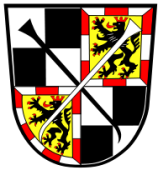 Bayreuth
(in northern Bavaria,) is on the Red Main river in a valley
Bayreuth
(in northern Bavaria,) is on the Red Main river in a valley
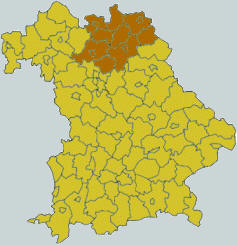 between the Frankish Alb and the
Fichtelgebirge mountain ranges. It has a population of 73,048 with a size
of 25.8 sq mi (66.92 km².) Its coat of arms is on the left. It is
the capital of Oberfranken or Upper Franconia (brown area in the map of Bavaria,
right.) With Middle and Lower Franconia, it makes up the old region of
Franconia. With a population of more than one million and more than 200
independent breweries which brew approximately 1000 different types of beer,
Upper Franconia has the highest rate of breweries per capita in the world.
There's also a special Franconia beer route (Fränkische Bräuereistraße) loosely
connecting the many breweries.
between the Frankish Alb and the
Fichtelgebirge mountain ranges. It has a population of 73,048 with a size
of 25.8 sq mi (66.92 km².) Its coat of arms is on the left. It is
the capital of Oberfranken or Upper Franconia (brown area in the map of Bavaria,
right.) With Middle and Lower Franconia, it makes up the old region of
Franconia. With a population of more than one million and more than 200
independent breweries which brew approximately 1000 different types of beer,
Upper Franconia has the highest rate of breweries per capita in the world.
There's also a special Franconia beer route (Fränkische Bräuereistraße) loosely
connecting the many breweries.
The city, believed to have been founded by the Counts of Andechs on an unknown
date in the Middle Ages, was first
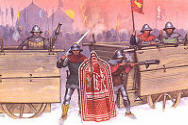 mentioned
in 1194 AD.
mentioned
in 1194 AD.
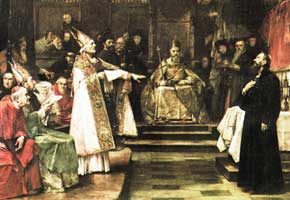 Some 60 years later, the tiny village became subordinate to
the Hohenzollern state. The
city suffered several plagues and wars until 1430 when it was destroyed
in the course of the Hussite
Wars (1420 to 1434.) It was the first European war in
which hand-held gunpowder weapons made a decisive contribution (above left.)
Also called the Bohemian Wars, it was all because of a Czech priest,
Jan Hus and it was all about
his "heresy" of demanding the obligation of the faithful to receive communion in
both kinds, bread and wine (sub utraque specie) as well as other reforms of the
Church. The war started when he was excommunicated at the Council of
Constance (above right, Hus in black) and burned at the stake by the King in
Koblenz in 1415 (below left.)
Some 60 years later, the tiny village became subordinate to
the Hohenzollern state. The
city suffered several plagues and wars until 1430 when it was destroyed
in the course of the Hussite
Wars (1420 to 1434.) It was the first European war in
which hand-held gunpowder weapons made a decisive contribution (above left.)
Also called the Bohemian Wars, it was all because of a Czech priest,
Jan Hus and it was all about
his "heresy" of demanding the obligation of the faithful to receive communion in
both kinds, bread and wine (sub utraque specie) as well as other reforms of the
Church. The war started when he was excommunicated at the Council of
Constance (above right, Hus in black) and burned at the stake by the King in
Koblenz in 1415 (below left.)

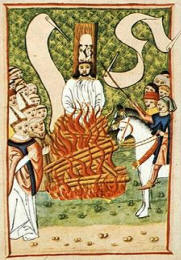
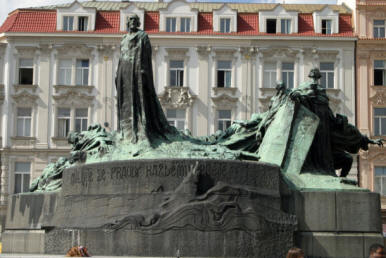
Jan Hus's last words are allegedly, "in a hundred years, God will raise up a man whose calls for reform cannot be suppressed." Martin Luther nailed his 95 Theses to a church door in Wittenberg 102 years later. Interestingly, nearly 6 centuries later, in 1999, Pope John Paul II expressed "deep regret for the cruel death inflicted" on Hus and he went on to suggest an inquiry as to whether Hus might be cleared of heresy. The Czechs erected a statue to him in Prague (above right.) It is a very interesting story.
In 1602 there was another plague in Bayreuth, and fires got it in 1605 and 1621.
The turning point of the town's history was in
 1603,
when Margrave (sort of duke-king) Christian of Kulmbach decided to move his
residence to Bayreuth. The development of the new capital stagnated due to
the Thirty Years' War, but
1603,
when Margrave (sort of duke-king) Christian of Kulmbach decided to move his
residence to Bayreuth. The development of the new capital stagnated due to
the Thirty Years' War, but
afterwards many famous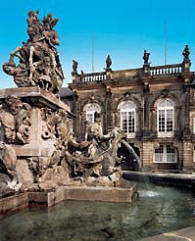 baroque buildings were added to the town. After Christian died in 1655,
his grandson Christian Ernst ruled from 1661 until 1712 and built the fountain
of the margraves and an equestrian monument (right,) placed at first in the
courtyard of the Old Castle and now in the middle of the square in front of the
New Castle (Neues Schloss, above.)
baroque buildings were added to the town. After Christian died in 1655,
his grandson Christian Ernst ruled from 1661 until 1712 and built the fountain
of the margraves and an equestrian monument (right,) placed at first in the
courtyard of the Old Castle and now in the middle of the square in front of the
New Castle (Neues Schloss, above.)
Bayreuth's Golden Age was during the reign of
Margravine
Wilhelmine (right,) the favorite sister of King Frederick II of Prussia.
Several parks and castles
 were
built
which constitute much of Bayreuth's present appearance, together with the Opera
of the Margraves (see below,)
were
built
which constitute much of Bayreuth's present appearance, together with the Opera
of the Margraves (see below,)
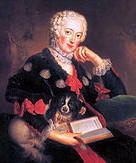 the most beautiful baroque theatre in Europe.
In 1769 the last margrave of the Principality of Bayreuth died without an heir,
and the state was annexed by the neighboring Principality of Ansbach.
Bayreuth was no longer a state capital. Later it became Prussian (1792),
then French (1806) and finally Bavarian (1810). In 1872 the composer
Richard Wagner moved to Bayreuth. Above left is the Wagner home (where
Hitler once stayed.)
the most beautiful baroque theatre in Europe.
In 1769 the last margrave of the Principality of Bayreuth died without an heir,
and the state was annexed by the neighboring Principality of Ansbach.
Bayreuth was no longer a state capital. Later it became Prussian (1792),
then French (1806) and finally Bavarian (1810). In 1872 the composer
Richard Wagner moved to Bayreuth. Above left is the Wagner home (where
Hitler once stayed.)
In the 1930s, Bayreuth became a scene of Nazi ideology, with Nazi leaders often attending the Wagner festival and trying to turn Bayreuth into a model Nazi town. It was one of several cities in which town planning was administered directly from Berlin.

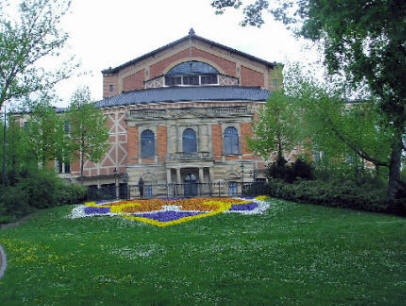
Hitler loved Wagner's music, and was a close friend of Winifred Wagner after she took over the Bayreuth Festival. Hitler (above left) frequently attended Wagner performances in the Bayreuth Festspielhaus (above today.) To learn more and see and hear Wagner, click the link above. Below left is how it looked in 1882 and on the right was Hitler's grand plans to redo it.
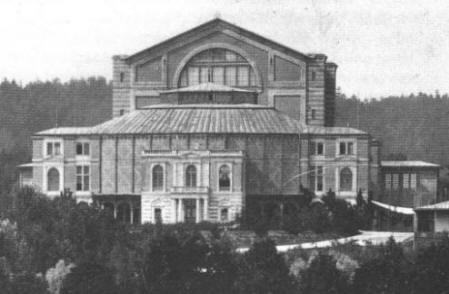
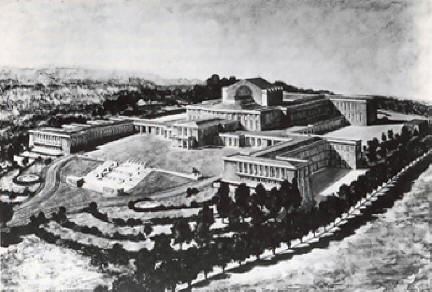
During World War II, a sub-camp of the Flossenburg concentration camp was located here. Bayreuth was heavily bombed at the end of the war and one third of the city was destroyed, killing about a thousand people. After the war, Bayreuth tried to part with its ill-fated past and the Wagner festival was restarted in 1951. In 1975 the University of Bayreuth was founded and largely contributed to the further growth of the city. There's the background of where we are.
This day celebrates our first week in Germany. I woke at 11:15 AM and got up at 12:15 which means my jetlag is really waning, but I still don't feel like writing diarios. As you can see, our room was nice if not huge.
I got down to the street and got a shot of the hotel (below left) and of the Opera of the Margraves (Markgräfliches Opernhaus) right next door (below right.) Pretty good location, huh?
It was built from 1746-1750 on plans by Bibiena and Saint-Pierre. Here are some stock photos of the interior of the opera house.
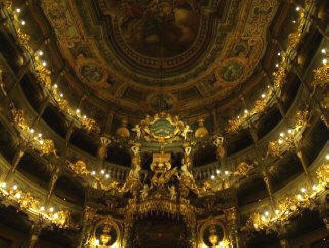

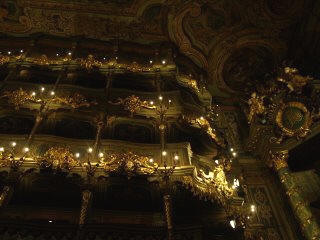
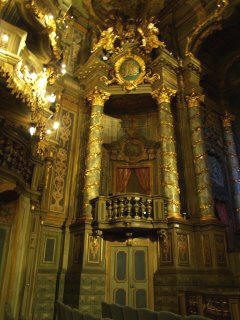
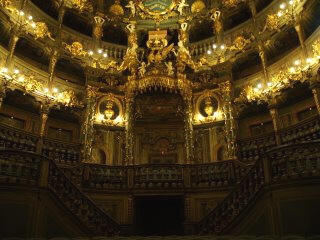
Below is the little cafe area outside the hotel nearby, which was very convenient.
At 12:45 I was on my run to the Bahnhof (train station) and at 1 PM came across a place called Gebers which had an outdoor sale on pillows. I ran in a bought 2 pillows for €10 and continued running. We can use them in the car or in the room if the ones provided aren't very good. I continued my run carrying the pillows. I finally got to the Bayreuth Hauptbahnhof (main train station) and ran inside. Below left, one more of the interior of the opera house and a sign showing the city's sister cities.
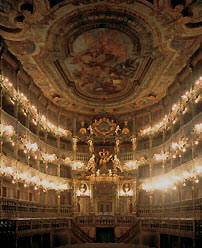

I went out the backside where the tracks are. It was very nicely done. As I kept running I came across a bridge over the city's major river, the Roter Main (Red Main.) It was hard to tell it was a river. It looked more like a drain. Next to it is a better stock photo of the river. As I got back into the city I was stopped in my tracks by this comical display on the building.
I had to admit that it was cute and certainly unusual for the staid Germans. Doesn't this look like American graffiti?
I got back to the hotel and at 3 PM Maja helped us check out of the hotel which was a little more expensive than the night before. Below left is there cute little courtyard in the back. We then headed out to explore the city and as I walked along I came across this photographers window.
As meandering can take you, I took photos of a lot of the architecture in the city. Below is a pretty fountain and a memorial to the two world wars.
Below is a shot of the Altes Rathaus (old city hall) on the left and the Neues Rathaus (new city hall) on the right. I like the old one.
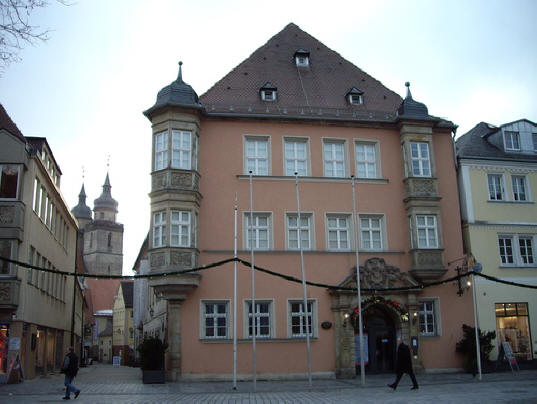
Above is the Bayerischer Hof Hotel. I finally reached this very large building which was just huge. It is the Old Palace (Altes Schloss.) It is a huge, four winged complex that date's back to the 13th Century. It was re-designed in the 16th and 17th Centuries, and rebuilt in the 1950's after being damaged in WWII. The Schloss stands out, as it is painted white, with rust color trimming's. It is here, in the Palace Church, that the Royal crypt stands, containing the sarcophaguses of the Margrave Friedrich and Margravine Wilhelmine. There is no way to stand back far enough to get it all in in one shot, so below is the PhotoStitch compilation so ignore the bends in the building.
In the courtyard is the statue of Maximilian II, King of Bavaria. Looking a little closer, above left, there are circular figures above each of the windows. Here are just a few examples. I don't know whether these are famous people or not but they were all different.
At 3:15 Marcia had lunch at Louis' Bistro [Ludwigstrasse 1,
![]() +49-921-786-6866.] She had a pizza and I had a
cappuccino and opened my computer and did AOL email and downloaded Rush.
+49-921-786-6866.] She had a pizza and I had a
cappuccino and opened my computer and did AOL email and downloaded Rush.
At 5:10 I bought a camera bag at Photomarkt for sale at €10 and then went into a Bäkerei and got 2 diet-cokes, water and pretzels. The following are photos of various areas in the city to give you a feel of the place.
Above right is the Altes Rathaus with the patio restaurant going full blast. Can you spot the McDonalds on the left photo below?
Then I came across an outdoor farmer's market with this tall "totem pole" with a ring wreath at the top. I didn't know what it represented until I studied the signs on it.
The symbols on the pole represent different professions; right below: Bäcker (baker) and Fleischer (butcher), center: Friseur (hairdresser) and left: Schlosser (locksmith.)
The farmer's market was full of wonderful fruits and vegetables.
This is white asparagus (spargel) season and they're selling for €3/lb while wassermelonen (watermelons) sell for €1/lb.
Since Germany is famous for its meat products, I had to get some photos of these beautiful displays in the Fleischer shop windows. On the right below you can see all the various wursts they have.
Here is a huge display of various salamis and bolognas.
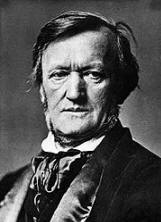 It was time to get going, so at 5:30, we got the car and drove to see the famous
Festspielhaus
which was built by Richard Wagner
(born May 22, 1813 in Leipzig and died February 13, 1883 in Venice.) You
can't leave Bayreuth without some attention to this famous composer know best
for his "Der Ring
des Nibelungen" (1876). The four operas of the Ring are: Das Rheingold
(The Rhinegold,) Die Walküre (The Valkyrie,) Siegfried and Götterdämmerung
(Twilight of the Gods.). For those not familiar with the story of
the Ring:
It was time to get going, so at 5:30, we got the car and drove to see the famous
Festspielhaus
which was built by Richard Wagner
(born May 22, 1813 in Leipzig and died February 13, 1883 in Venice.) You
can't leave Bayreuth without some attention to this famous composer know best
for his "Der Ring
des Nibelungen" (1876). The four operas of the Ring are: Das Rheingold
(The Rhinegold,) Die Walküre (The Valkyrie,) Siegfried and Götterdämmerung
(Twilight of the Gods.). For those not familiar with the story of
the Ring:
Wagner created the story of the Ring by fusing elements from many German and Scandinavian myths and folk tales. The Old Norse Eddas supplied much of the material for Das Rheingold.
The plot revolves around a magic ring that grants the power to rule the world, forged by the Nibelung dwarf Alberich from gold stolen from the river Rhine. Several mythic figures struggle for possession of the Ring, including Wotan (Odin), the chief of the gods. Wotan's scheme, spanning generations, to overcome his limitations, drives much of the action in the story. The hero Siegfried wins the Ring, as Wotan intended, but is eventually betrayed and slain. Finally, the Valkyrie Brünnhilde, Siegfried's lover and Wotan's estranged daughter, returns the Ring to the Rhine. In the process, the Gods are destroyed.
Wagner's life was quite tumultuous and debt-ridden.
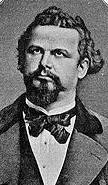 Without
the support of Bavarian
King Ludwig II (left,) he would never
Without
the support of Bavarian
King Ludwig II (left,) he would never
 had
made it. It was Ludwig that helped pay for the opera house where his
operas would be staged by him. When Wagner married his second wife it made him a
son-in-law of Franz Liszt
(right.) Wagner's strong and published anti-semitism leads many to believe
he was an inspiration for that of Hitler's. No Wagner opera has ever been
staged in Israel.
had
made it. It was Ludwig that helped pay for the opera house where his
operas would be staged by him. When Wagner married his second wife it made him a
son-in-law of Franz Liszt
(right.) Wagner's strong and published anti-semitism leads many to believe
he was an inspiration for that of Hitler's. No Wagner opera has ever been
staged in Israel.
It is interesting that the only opera Marcia and I have ever attended was one by Wagner staged in the beautiful opera house in Budapest in 1997. I didn't understand a thing especially since the electronic translator overhead was in Hungarian. In the courtyard is a tribute to Richard Wagner.
Well, enough for operas. It was starting to get late and time to move on and leave Bavaria and head north to Saxony. At 5:45, Marcia drove the 95 miles from Bayreuth to Chemnitz. We are now entering the real East Germany in the region called Saxony.
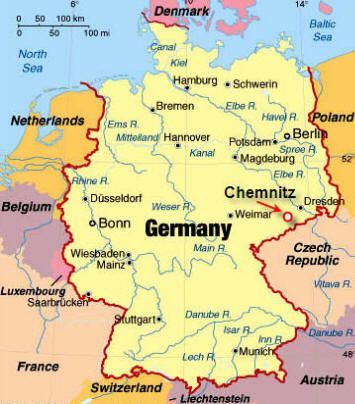
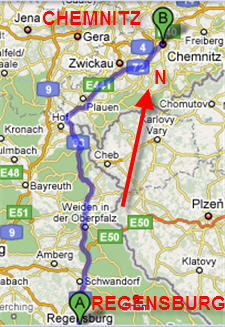
After an hour into the trip, at 6:40, a very heavy rain storm ensued making
driving difficult. This is the beginning of the worst weather we have had
during the summer on all of our seven trips. I had chosen and booked a hotel
in Chemnitz called the Schlosshotel in Klaffenbach [![]() +49-371-2-6110.] We
arrived there in the pouring rain at 7:45 and the first thing I notice is that
it is huge and no where near the city center. Then it appears that there
is some big event going on and its some kind of golf
club. I felt I had made a booking mistake here, which is rare but on these
trips, I don't compromise.
+49-371-2-6110.] We
arrived there in the pouring rain at 7:45 and the first thing I notice is that
it is huge and no where near the city center. Then it appears that there
is some big event going on and its some kind of golf
club. I felt I had made a booking mistake here, which is rare but on these
trips, I don't compromise.
Since I hadn't paid anything yet, I got on the GPS and did a search for Accor hotels in Chemnitz and found a Mercure in the downtown; I called them and got a room. I then called this hotel and cancelled and we got back on the road so the GPS could get us there. One big benefit of having cell phones. From the map (below,) you can see the Schloss-Chemnitz (upper left) is not that far away but out in a park. Also notice there is a large lake (center) in the central city, not that far from the rail station (right.)
We
![]() arrived in the Zentrum (center) and wended our way through the streets and
found our hotel. At 8 PM we checked into the
Mercure
Hotel Kongress Chemnitz
(Rm #1918) [Brückenstraße 19,
arrived in the Zentrum (center) and wended our way through the streets and
found our hotel. At 8 PM we checked into the
Mercure
Hotel Kongress Chemnitz
(Rm #1918) [Brückenstraße 19,
![]() +49-371-6830] and unpacked our bags. The
room was comfortable with plenty of room.
+49-371-6830] and unpacked our bags. The
room was comfortable with plenty of room.
I set up my usual routine for charging everything. Below is an example. The multi-plug allows charging our two cellphones (on the left, the one that Dimitrii lent me and the little red Nokia I bought for Marcia in Vienna,) the camera battery charger (on top,) the video camera battery charger (on the right) and the VAIO laptop with accessory hard drive (on the left.)
The Palm phone charging is not plugged in yet. That's what I record the Diarios with. I do this hookup as soon as I get into the room and it is the last thing I pack before we leave. We then went downstairs to the hotel bar to have our mandatory Accor "welcome cocktail." Marcia had a weissewine and I had a stein of Warsteiner, which is a common beer throughout Germany.
The hotel was originally built by the East German communist government and when Accor got it they did a whole refurbishment. It is the tallest building in the city. It is a 3-star Kongress hotel mainly for meetings. The whole lobby is dedicated to a museum of automobiles and motorcycles. I never figured out why.
After looking at all the displays, at 9:20 we took a cab to find the restaurant
recommended to us by the hotel. At 9:30 we found the the Ratskeller
Chemnitz
[Markt
1,
![]() +49-371-694-9875.] First you climb down the stairs under the "Hearty
Welcome" sign and then enter the dining hall.
+49-371-694-9875.] First you climb down the stairs under the "Hearty
Welcome" sign and then enter the dining hall.
Here was the menu for the Ratskeller, our first example of the old East Germany.
.jpg)
.jpg)
Pictures really can't demonstrate the incredible feeling and beauty of this place. You're in the cellar, but the ceilings and arches held by columns almost give the impression of the Moorish architecture you see in Andalusia, Spain. Note the shiny gold at the top of the columns. They are the outline and background for humorous characters engraved in the marble (see below.)
We sat down at a nice table against the wall and and after the waiter saw me taking pictures, he took this one of us. Below are the gold-encrusted carvings on the columns. The first is of a dragon threatening this guy whose neck is encircled by a snake.
On the left, a man riding a snail backwards and on the right a guy being squeezed by a wine press with a load of something coming out his backside.
On the left (below) is a man with a toothache and the other, a musician writing.
There were many more but I decided not to photograph all of them. Since Germany is about beer, it is important for me to try as many different types as I can. This is a task I am up to, since I began this endeavor when I was 13 years old in Troy, New York. I first had a Radeberger pils (below left) with my goulash followed by an Einsiedler Landbier (below right) during my entree. Both were very good.
My dinner consisted of a goulash soup with kidney beans to start and then a beef sauerbraten with red cabbage and potato pancakes. I learned that "creme fraich" here means plain sour cream. This was all very good.
Marcia enjoyed the chardonnay she ordered and the two seltzerwassers. For an appetizer she had tomaten salat (tomato salad) with feta cheese, lettuce and a radish (I had to eat the radish.) For dinner she had her favorite, Wildlachs vom rost (roasted salmon) with weiss spargle (white asparagus) and Kartoffeln (potato) fritter sticks. She said it was pretty good. Not bad for a total of €50 for both of us for everything.
After dinner we toured the keller and took some photos and at 11 PM we left and walked back to the hotel. At 11:30, I had two cappuccinos at the hotel bar and worked on the maps trying to lay out the rest of the trip through Saxony and East Germany. I have to plan the right scheme to get to Roma in time for Kevin's wedding. I went to bed at 2 AM.
Kenneth J. Hoffer, MD
Chemnitz, Germany
3-25-2009
If you enjoyed these travels or wish to add comments on the places we visited
Please Leave Me a Message by clicking the spinning @ sign.


We Have Now Toured All the Major Countries in Western Europe
Photos May Be Downloaded or Printed by Right-Clicking on Them
© Copyright 2009 Kenneth J. Hoffer, MD